What Hi-Fi? Verdict
With its impressive performance and premium design, the Bild i.55 sees Loewe returning to the UK in style
Pros
- +
Good all-round performance
- +
Premium design and build quality
- +
Impressive ‘Klang’ soundbar option
Cons
- -
No 4K/120Hz gaming support
- -
Some problematic motion handling
- -
Less bright than some OLED rivals
Why you can trust What Hi-Fi?
When Loewe withdrew from the UK TV market back in 2019, it was by no means clear whether the premium German brand would ever be able to find its way back. In fact, with more and more aggressively priced competitors entering the TV market, the odds seemed to be stacked against it.
Given the brand’s proud history of delivering beautifully built TVs with innovative and bespoke design elements, strong performance standards and unique upgrade options, though, we were happy to see Loewe announce late in 2021 that it was getting back into the UK TV game. Especially when it added that its return was going to find the brand working to a faster product design cycle than it had been before, ensuring that its new TVs would be better able to keep up with the relentlessly fast pace of innovation in today’s TV world.
The Bild i.55 is the debut result of Loewe's ‘rebirth’ – and while it’s a chip off the lovely old Loewe block in some ways, it does indeed suggest that Loewe in 2022 is a significantly nimbler and more focused brand than it was before.
Price
The £2999 / AU$4999 (around $3400) price of the Loewe Bild i.55 puts it very much in the premium tier of today’s TV market. To give you some idea of just how premium, LG’s OLED55C2 costs just £1199 / $1300 / AU$3195 at the time of writing, while Sony’s XR-55A80K OLED TV costs £1499 / $1300 / AU$2595. Even the impressive new QD-OLED TV variants, the Samsung QE55S95B and Sony XR-55A95K, only currently cost £1199 / $1500 / AU$2995 and £2199 / $3000 (around AU$3895) respectively.
This puts the Bild i.55 at an immediate disadvantage, clearly. Especially as it’s built around the traditional ‘WRGB’ type of OLED technology rather than the newer QD-OLED approach. Loewe’s set does offer some unique features to help justify its cost, though.
Its design and build quality are a clear cut above the norm, for instance. Its chassis is also designed to accept a supremely elegant soundbar upgrade as and when you want to add it and, uniquely for today’s TV market, it sports a built-in hard disk video recorder with 1TB of storage space.
It’s even possible to attach the Bild i.55 to a choice of different stand and wall-mount options, including a unique floor-to-ceiling pole mount.
While these premium features still won’t be enough to make the Bild i.55 a truly mainstream TV option, that’s not really the point. To the sort of well-heeled, design-oriented customer Loewe is targeting, though, the Bild i.55’s proposition really could do enough to win plenty of customers to its premium cause. Especially when the cheapest 55-inch TV currently available from that other famous premium designer TV brand, Bang & Olufsen, costs £5800 / $6975 / AU$14,091.
Design
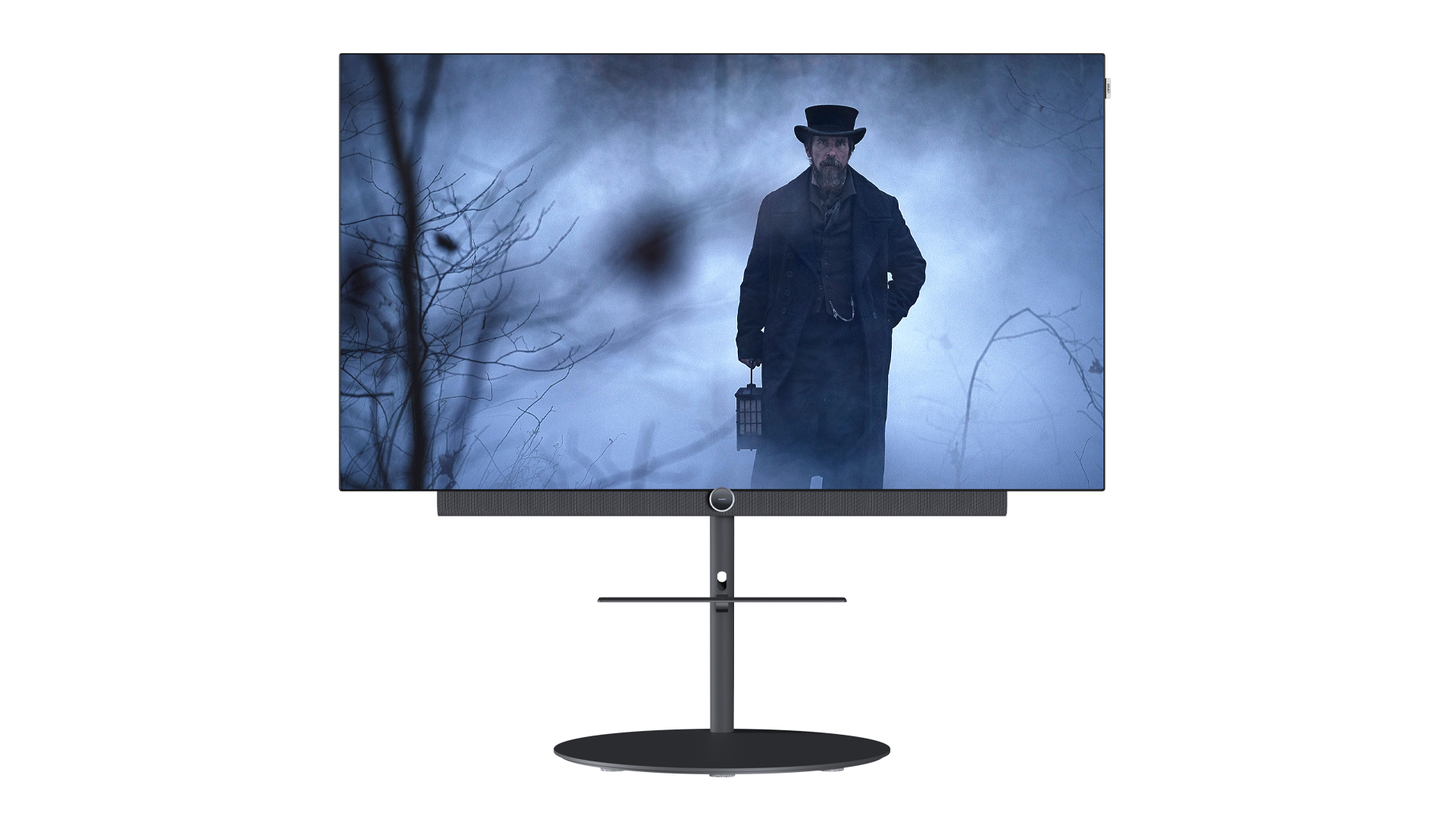
The Loewe Bild i.55 really is a thing of beauty. The OLED screen is supported on a fantastically finished brushed black metal panel that’s also outrageously slim at its outer edges. The frame around the screen is super slim too, and appears to sit flush with the screen, making its presence even less of a distraction from the pictures on the screen.
Inevitably for a TV that wants to take sound quality seriously and doesn’t use the sort of Acoustic Surface ‘screen as speaker’ technology deployed by Sony’s OLED TVs, a large section – around two-thirds – of the Bild i.55’s rear sticks out much further than it does at its edges. This bulgy bit still looks elegant on the Bild i.55, though, thanks to the way much of it is covered by a rich, graphite-grey cloth cover.
Projecting from the TV’s upper right side is the distinctive Loewe ‘label’ we remember from Loewe TVs in days gone by, while hanging off the bottom edge it’s great to see Loewe retaining its trademark large, circular LED display and IR sensor design feature.
Our sample is fitted to a fantastically well-built and well-finished pole-style desktop neck, which sits on an equally well-made brushed metal plate stand. You can hide cabling in the pole neck, and there’s cable channelling in the recessed connections area on the back of the TV, too.
Put all these design elements together and you’ve got a TV that looks supremely elegant and emphatically premium from every angle.
Remarkably, despite the unified elegance of the Bild i.55’s design, it’s possible to add an optional extra ‘soundbar’ speaker arrangement to it without it spoiling the aesthetic at all. This Klang Bar i accessory simply slots onto the TV’s bottom edge and, since it wears the same fabric finish that you get on the TV’s rear, you’d barely know by looking at the TV that anything had changed. Apart from the new couple of inches of grey fabric that now protrude below the bottom edge, of course.
As noted in the price section, you can make the Bild i.55 look even more dramatic by attaching it to optional elegant wall mount options, a floor-standing pole mount, or a dramatic ‘floor2ceiling’ pole stand.
The Loewe Bild i.55 is partnered with a beautiful metallic remote control that feels lovely to hold and feels like pretty much the perfect premium interface for such a gorgeously made TV.
Features
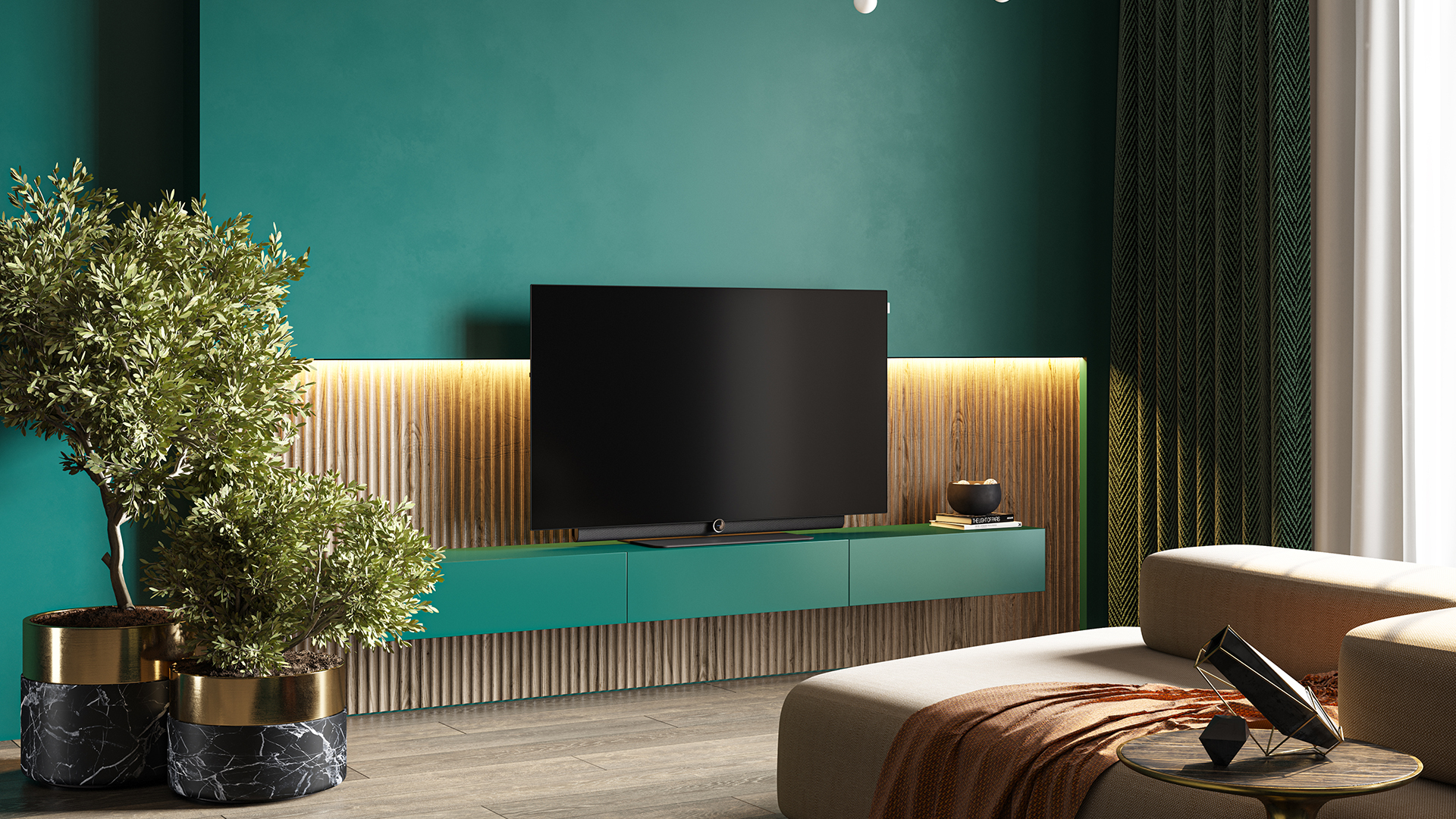
The Loewe Bild i.55 is built around a traditional 4K-resolution WRGB OLED panel, offering support for the HDR10, HLG and Dolby Vision HDR formats. There’s no HDR10+ support, which is a shame when the likes of Philips and Panasonic support all four of the main HDR formats on their latest OLED TVs. To be fair, though, neither LG nor Sony support HDR10+ on their OLED TVs either, while Samsung’s QD-OLED TVs – and their Mini LED TVs – support HDR10+ but not Dolby Vision.
It’s unclear whether the Bild i.55 uses one of the latest premium ‘EX’ OLED panels – though its brightness during testing suggests that it doesn’t. We can say with certainty, though, that unlike a fair number of rival premium OLED TVs this year, the Bild i.55 doesn’t sport a heat sink layer that would help it run more brightly without increasing the risks of permanent screen burn.
As ever with OLED TVs, the assumed advantages of Loewe using the technology are a pixel-level degree of local contrast, deep and uniform black levels, and wide viewing angles.
The Bild i.55’s smart system, surprisingly, is the VIDAA platform developed by Hisense. It’s certainly not unique to see VIDAA on TVs that aren’t Hisense models; it’s something Hisense now licenses out rather than keeping exclusively for its own TVs. But it initially feels surprising to see Loewe no longer sticking with its own proprietary smart platform for its first TV back on the UK scene.
Given the difficulties and delays, though, associated with a relatively small brand such as Loewe constantly having to develop and refine its smart platform and trying to do content deals for all the apps consumers expect to see these days, the switch to VIDAA ultimately suggests a more practical Loewe thinking on its feet to find ways of delivering all the features consumers want to see. Especially as VIDAA has now gone from rather humble beginnings a few years back to being an impressively straightforward and content-rich platform.
Also unexpectedly, the Bild i.55’s relationship with Hisense seems to stretch to some of its picture setting options as well. Certainly, the structure and phrasing of areas of the Bild i.55’s set-up menus is strikingly similar to stuff we’ve seen on recent Hisense TVs.
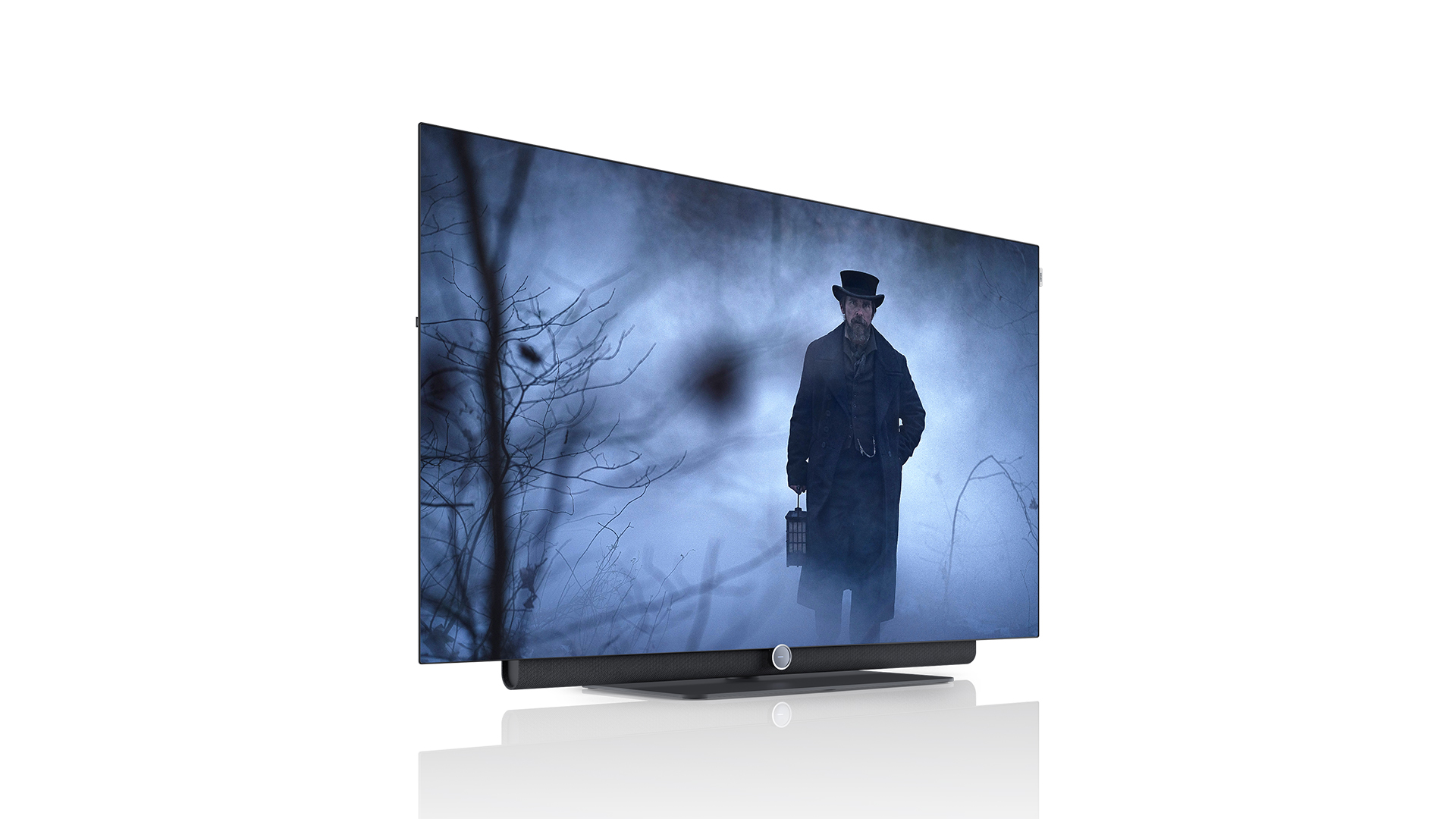
Screen size 55 inches (also available in 48in, 65in)
Type OLED
Resolution 4K
HDR formats HLG, HDR10, Dolby Vision
Operating system VIDAA
HDMI inputs x4
HDMI 2.1 18Gbps, x4
Gaming features VRR (48-60Hz), ALLM, Dolby Vision gaming (up to 60Hz)
ARC/eARC eARC
Optical output Yes
Dimensions (hwd, without stand) 73 x 124 x 6.4cm
At first glance the Bild i.55’s connectivity looks strong. In particular, there are four HDMIs, all of which are claimed to support HDMI 2.1. It turns out, though, that this really just reveals how unhelpful the HDMI labelling system has become these days, as none of the HDMIs proves capable of handling the 4K/120Hz signals now available from the PS5, Xbox Series X and high-end PCs. The HDMIs do support the eARC audio feature for passing lossless Dolby Atmos to compatible soundbars or AV receivers, as well as VRR gaming up to 60Hz, and ALLM.
To be fair, the Bild i.55 isn’t particularly targeted at the gaming world. Given that almost all other TV brands now support 4K/120Hz on at least their premium models, though, it would still have been nice to find Loewe’s comeback kid also ticking this gaming box.
Gamers won’t be especially impressed, either, by the 43.5ms the Bild i.55 takes to render images it receives at its HDMI inputs when running in its Game preset.
The Bild i.55 supports Dolby Atmos audio alongside its Dolby Vision video support. This is delivered in the TV’s out-of-the-box condition by a 20W speaker system, but you can upgrade this to 80W and add forward-facing drivers by attaching the specially designed Klang Bar i to the TV’s bottom edge.
One last classic Loewe touch to mention here is the Bild i.55’s DR+ system. This is essentially a built-in 1TB hard disc recorder you can use for recording shows from the built-in Freeview HD tuner. In these days of endless online content and catch-up apps, being able to record from a tuner perhaps feels a bit old school. That said, 1TB is a lot of space to play with, and the ongoing popularity of Sky Q proves that there are plenty of people out there for whom time-shifting live broadcasts is still a big part of their AV lives.
Picture
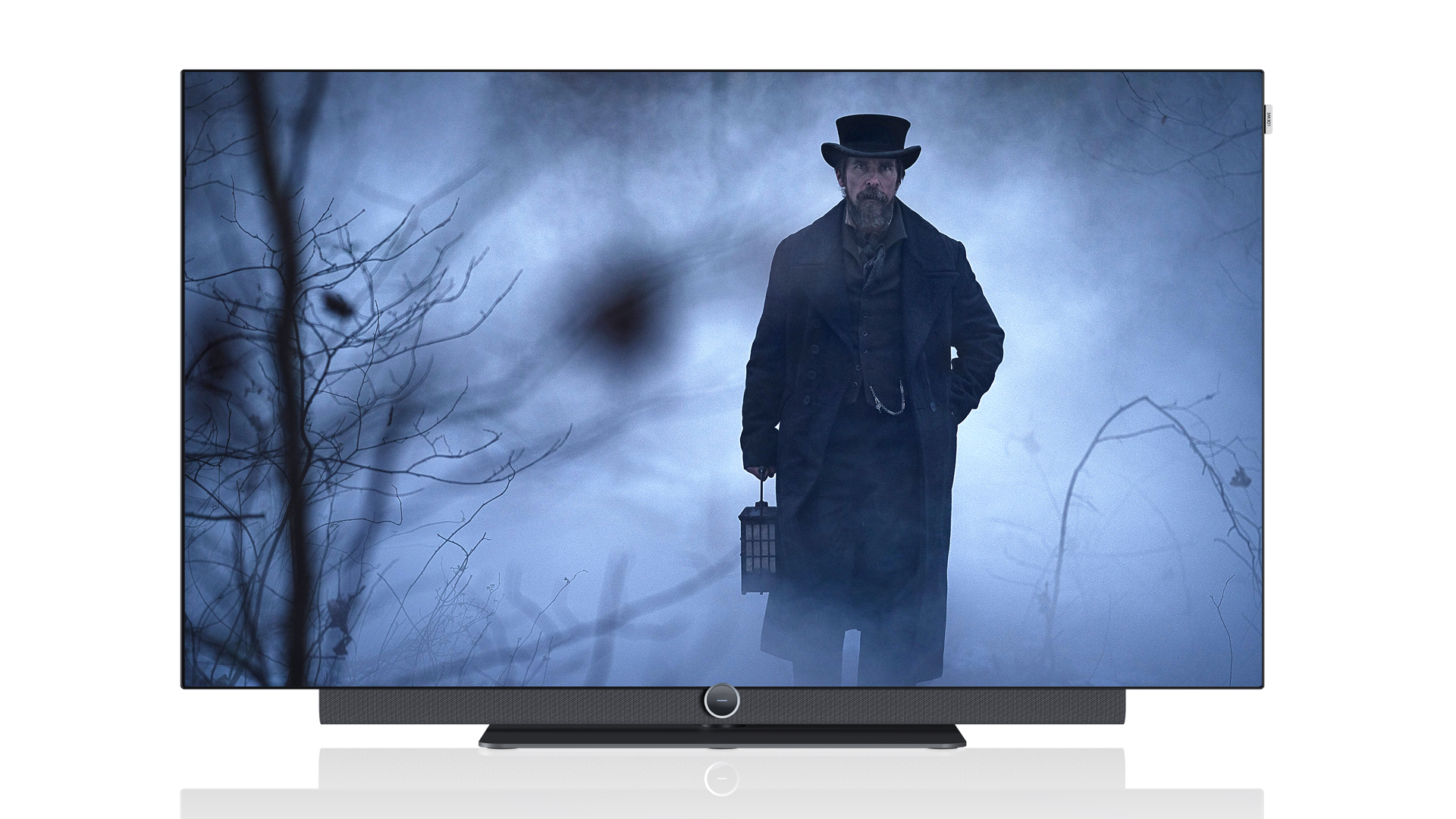
As you’d hope with any modern OLED TV, the Bild i.55’s picture quality is mostly excellent. Even quite beautiful at times.
Its combination of pretty much perfect black levels and pixel-level contrast and light control is the star of the show. Even the best LCD TVs just can’t handle stuff such as stars against a night sky or torchlight cutting through a dark room with as much purity and impact as the Bild i.55’s OLED panel can.
The darkest pixel in any given image can sit literally right adjacent to the brightest one and still there will be no compromise between the two. In other words, the brightness of the bright pixel isn’t reduced because there’s a dark one next to it, while the black pixel doesn’t slide up towards greyness because there’s a bright one next to it. There’s no overstating how much impact this can give to dark HDR scenes. Despite the Bild i.55 not being, as we’ll see later, the brightest OLED TV in town.
The black levels remain intact, too, if you have to watch the Bild i.55’s OLED screen from an angle. There’s none of the slide into greyness that you see with off-axis viewing with (most) TVs that use LCD technology.
Good black levels usually prove to be a strong foundation for excellent colour handling, and so it proves with the Bild i.55. Saturation levels are rich and vibrant with both bright and dark scenes, and there’s enough subtlety in their tones to deliver natural-looking, smooth blends that help give images the sort of three-dimensional feel we look for from a good 4K TV.
The impressively nuanced colour presentation is a factor, too, in the picture’s excellent sharpness and detailing. With good quality native 4K sources the Bild i.55 delivers an emphatically 4K picture despite the relatively compact 55-inch screen size. It’s a solid upscaler of HD too, though not quite on the same level as the very best upscaling brands in town.
The Bild i.55 does a good job of tone mapping HDR10 sources to its screen’s capabilities, delivering them with good punch and control, and minimal clipping. The set responds nicely to Dolby Vision sources too, delivering more extra dynamic range impact than we’d usually see with a premium TV.
While the picture quality of Loewe’s comeback TV is seriously lovely for most of the time, it does come up short of the very best rivals in one or two areas. For one thing, its pictures aren’t particularly bright. Even in its rather over-cooked Dynamic preset it’s clearly less bright than 2022’s best premium OLEDs. It simply doesn’t deliver HDR images, especially full-screen bright HDR images, with the same sort of punch and intensity that you can get from the likes of the LG C2, Panasonic LZ1500B, Sony A95K or Samsung S95B.
You can improve the slightly dull look to the Bild i.55’s out-of-the-box performance by first turning off the TV’s ambient light sensor (which makes the image really very dark indeed if you’re watching the TV in a dark room), and then nudging the TV’s Backlight setting up towards its Maximum level. But ultimately there’s always an upper limit to the Bild i.55’s brightness that it can never push past.
Perhaps connected to the Bild i.55’s slight lack of brightness, dark scenes while playing Dolby Vision sources can lose a bit of shadow detail in dark picture areas, leaving them looking a touch hollow.
The last issue we have with the Bild i.55’s picture quality concerns its motion performance. Judder and resolution loss feel slightly aggressive with no motion processing in play, yet most of the motion processing options provided are pretty messy, causing either uncomfortable stuttering or distracting processing side effects. There is, fortunately, a workable solution in the shape of a Film motion processing option, which manages to improve the panel’s default motion performance without throwing up excessively unnatural results. Motion is still an area for Loewe to improve on in the future.
Sound
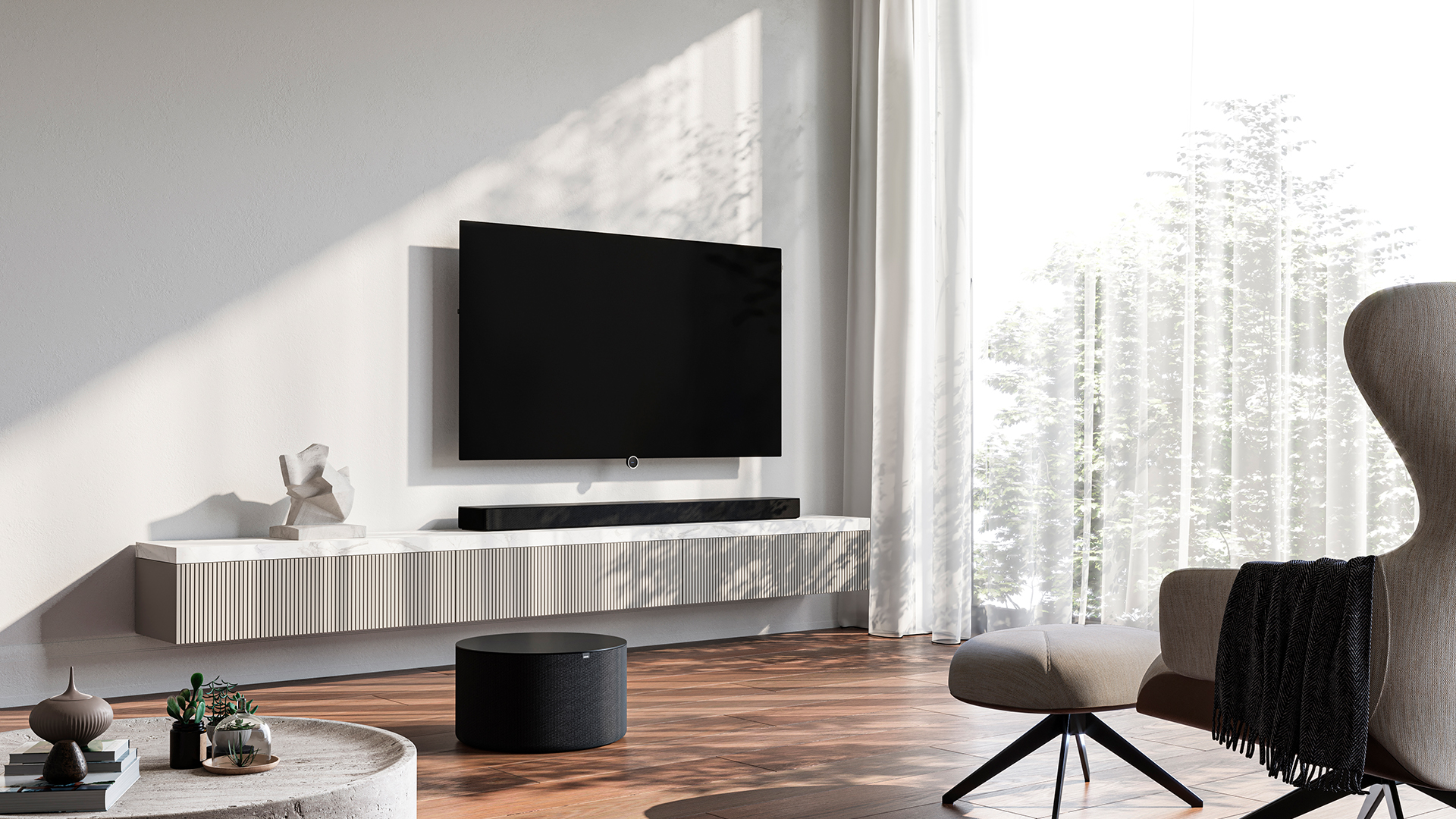
We test the Loewe Bild i.55’s sound using both its default speaker system, and its optional extra Klang Bar i ‘soundbar’.
Starting with the default speakers, they sound better than their 20W power rating would lead you to expect. They’re powerful enough to hit potent volume levels without becoming harsh or contained, and their dynamic range delivers an open, well-rounded sound that doesn’t easily become overwhelmed or break down into distortions or dropouts during dense soundtrack moments.
Voices sound clear and convincing, the soundstage is reasonably large and the speakers are sensitive enough to reveal lots of clean, convincing detailing. These details enjoy a mild but effective sense of specific placement in the TV’s soundstage when playing Dolby Atmos soundtracks, too – though this doesn’t extend to much room-filling forward impact.
This is where the Klang Bar i comes in. The way its clever design allows it to introduce an array of forward-facing drivers instantly contributes to a much more impactful, direct and dramatic sound. The sound swells in scale sharply as it leaves the Klang Bar i too, creating a larger soundstage which, usefully for the Bild i.55’s Dolby Atmos ambitions, has at least a little vertical as well as horizontal presence.
Having eight drivers and much more power to play with also brings out even more detail and clarity with dense movie mixes, as well as introducing a welcome boost to bass.
There are a couple of niggles with the Klang Bar i, though. It can sometimes make voices sound as if they’re coming from slightly below the on-screen action, and surprisingly it tends to fall away/recede slightly as escalating soundtrack moments head towards a crescendo. The sort of soundtrack moments that trigger this are thankfully rare, and it’s actually quite a common phenomenon in the integrated TV sound system world. It still feels a bit unnecessary for an audio system with as much power to play with as the Klang Bar i, though.
Verdict
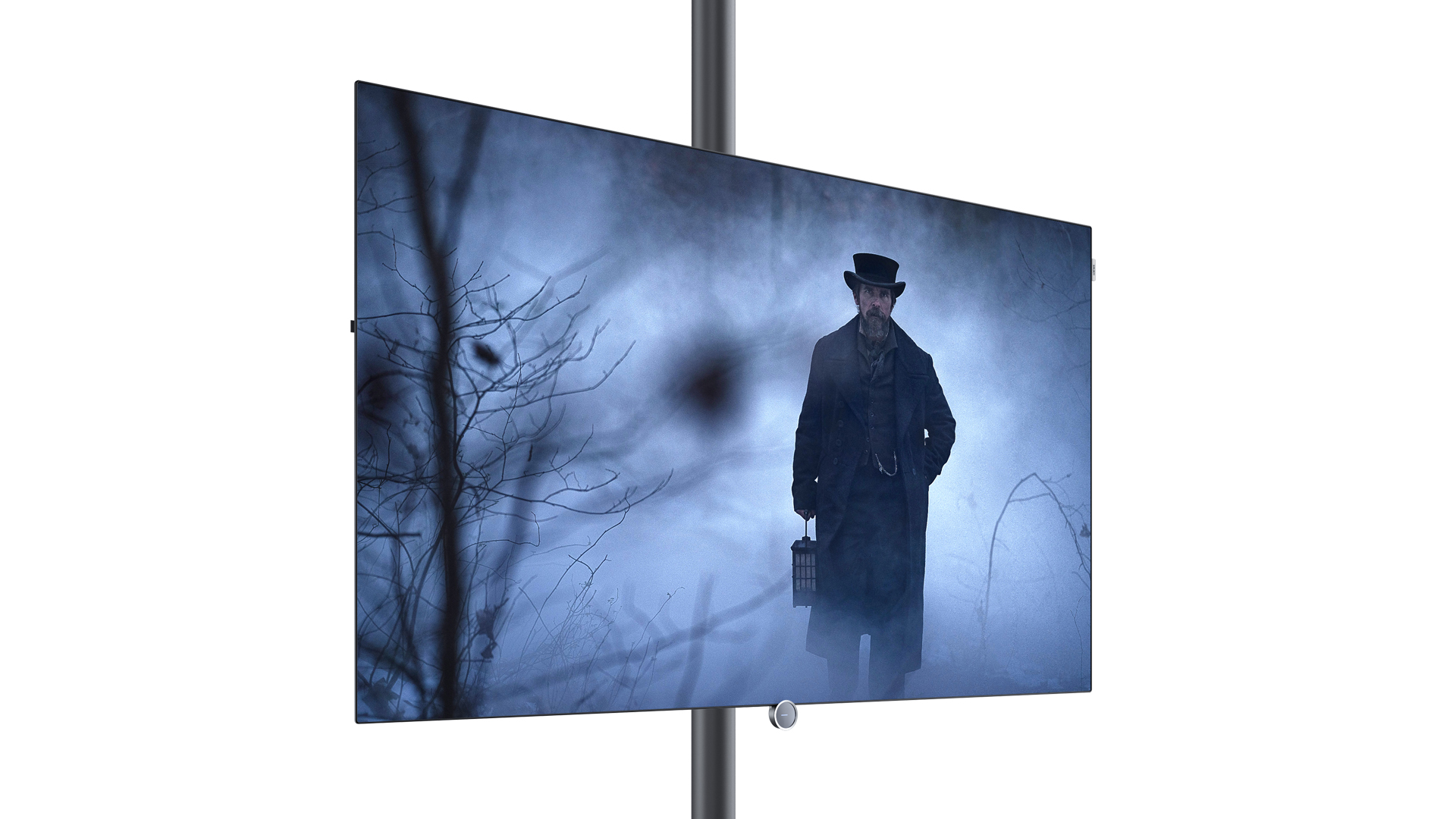
The Loewe Bild i.55 sees the German brand making a confident and desirable return to the UK. It instantly looks and feels like a classic premium Loewe TV, but at the same time there are clear signs that the old design elegance is now being partnered with a much more pragmatic and responsive approach to keeping up with the TV tech Joneses. Picture and sound quality are both engaging too, especially if you add the Klang Bar i, so while the Bild i.55’s price will clearly limit its market, it does enough as an all-round package to likely make that market very happy indeed.
SCORES
- Picture 4
- Sound 4
- Features 4
MORE:
Read our review of the Sony XR-55A95K
Also consider the LG OLED55G2
What Hi-Fi?, founded in 1976, is the world's leading independent guide to buying and owning hi-fi and home entertainment products. Our comprehensive tests help you buy the very best for your money, with our advice sections giving you step-by-step information on how to get even more from your music and movies. Everything is tested by our dedicated team of in-house reviewers in our custom-built test rooms in London, Reading and Bath. Our coveted five-star rating and Awards are recognised all over the world as the ultimate seal of approval, so you can buy with absolute confidence.

